LETS SOLVE TOUGHER PROBLEMS IN MIXTURE & ALLIGATION-HOW TO SERIES
Want to Become a Bank, Central / State Govt Officer in 2020?
Join the Most awarded Coaching Institute & Get your Dream Job


Now Prepare for Bank, SSC Exams from Home. Join Online Coure @ lowest fee
Lifetime validity Bank Exam Coaching | Bank PO / Clerk Coaching | Bank SO Exam Coaching | All-in-One SSC Exam Coaching | RRB Railway Exam Coaching | TNPSC Exam Coaching | KPSC Exam Coaching
LETS SOLVE TOUGHER PROBLEMS IN MIXTURE & ALLIGATION-HOW TO SERIES
Hi Bankersdaily Aspirants
Learning is a step by step process and you should gradually progress in that to ace the process. As you all know we have started a new Learn Series to help with your preparations for various exams like IBPS PO , IBPS RRB Scale I officer , IBPS RRB Office Assistant , IBPS Clerk , IBPS SO , SBI PO , SBI Clerk , SBI SO and many other exams in this type. Nevertheless this series will also contribute you all the tips and tricks to every miscellaneous sections and also all the important topics which are asked in the exams.
We had already discussed Mixture and Alligation topic & how it is used in other Concepts.If you haven’t looked it Check it now
TRICKS TIPS AND SHORTCUTS FOR SOLVING PROBLEMS IN MIXTURE AND ALLIGATION-PART 1
TRICKS TIPS AND SHORTCUTS FOR SOLVING PROBLEMS IN MIXTURE AND ALLIGATION-PART 2
TRICKS TIPS AND SHORTCUTS FOR SOLVING PROBLEMS IN MIXTURE AND ALLIGATION-PART 3
1)BASED ON FINDING INDIVIDUAL CAPACITY 2)BASED ON DIFFERENT CAPACITY 3)BASED ON RATIO’S
1)A jar contains a mixture of Milk & Water in the ratio 4:1.When 10 Litres of the mixture is taken out & 10 litres of water is poured into the jar,the ratio becomes 2:3.How many litres of Milk was in the Jar?

PRACTICE THIS SUM:
1)A Vessel Contains mixture of liquids A and B in the ratio 3:2.When 20 litres of the mixture is taen out and replaced by 20 litres of liquid B,the ratio changes to 1:4.How many litres of liquid A was there initially present in the vessel?
2)A can contains a mixture of two liquids in proportion 7:5.When 9 litres of mixture are drawn off and the can is filled with B,the proportion of A and B becomes 7:9.How many litres of liquid A was contained by the can initially?
#.2.TYPE 2:
BASED ON DIFFERENT CAPACITY:
1)Three glasses of Sizes 5 litres,10 litres & 15 litres contain mixture of Milk & Water in the ratio 3:2,4:6&4:11 respectively.The Contents of all the three glasses are poured into single vessel.Find the ratio of Milk to Water in the resultant mixture.
To find the Ratio of Milk to Water in the resultant Mixture,
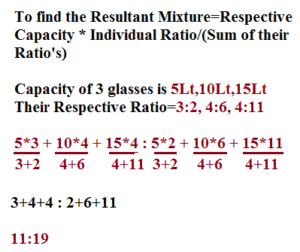
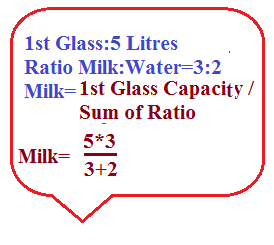
PRACTICE THIS SUM:
1)Three bottle of Capacity 6 Litres,12 Litres and 4 litres contain mixture of Sugar water and honey in the ratio 1:5 , 7:5 & 1:3 respectively.The contents of all the three bottles are poured into single bottle.Find the ratio of Sugar water to honey in the resultant mixture?
2)Four glasses of sizes 2Litres,8 Litres,12 Litres & 16 Litres contain mixture of milk & Water in the ratio 1:1 ,3:5,7:5,9:7 respectively.The Contents of all the four glasses are poured into single glass.Find the ratio of Milk & Water in the resultant Mixture?
#.3. TYPE 3:
BASED ON RATIO’S:
1)In an Alloy,Zinc and Copper are in the ratio 3:4,In the Second alloy the same elements are mixed in the ratio 7:2.In what ratio should these two alloys be mixed to form a new alloy in which the two elements are in the ratio 5:6?
The ratio is written as
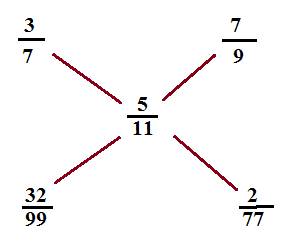
The ratio is 32/99:2/77
PRACTICE THIS SUM:
1)In an alloy the Zinc & Copper are in the ratio 1:3.In the Second alloy the same elements are in the ratio 4:3.In what ratio should these two alloys be mixed to form a new alloy in which the two elements are in the ratio 4:5?
2)A jar full of lime juice contains juice and sugar water in the ratio 2:3.In the 2nd Jar the same elements are in the ratio 7:2.In what ratio should these two elements be mixed to for a new alloy in which the two elements are in the ratio 6:5?



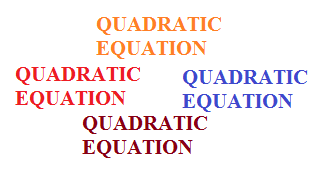
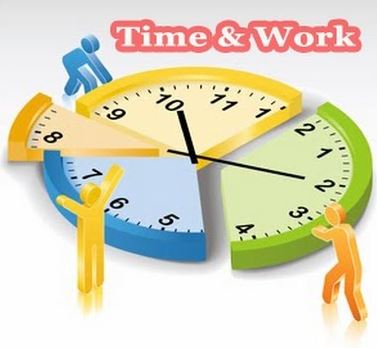

3 comments
Mam can you explain the practice sums under type 1
Please provide the explanation for 2nd qn under type 2 and both the questions under type 3
Hi Mam,
TYPE 2: 2nd Question:
(2*1/2)+(8*3/8)+(12*7/12)+(16*9/16):(2*!/2)+(8*5/8)+(12*5/12)+(16*7/16)
20:18
10:9